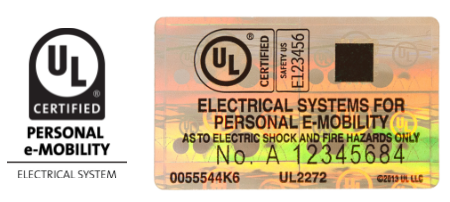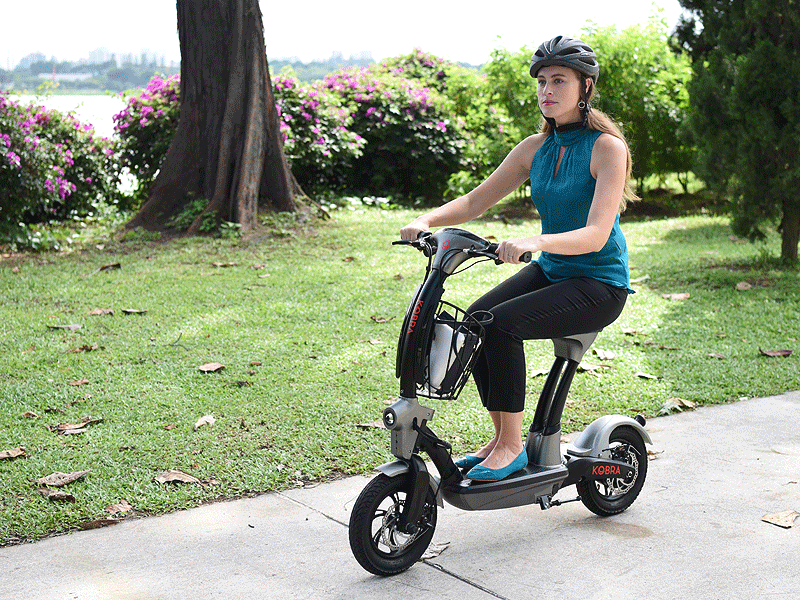Whatsapp Us Today! Join Now


Singapore has arguably the most number of electric scooter or personal mobility devices (PMDs) riders per capita than any other country in the world. The compact city state’s well-paved sidewalks make it an excellent environment for commuting on bicycles and electric scooters.
In early September of 2018, an announcement from the Land Transport Authority (LTA) of Singapore surprised electric scooter riders and sellers alike.
The authority had just announced their intention to adopt an obscure American fire and electrical safety standard as a requirement for PMDs. By 2021, only devices which comply with the standard will be allowed to be ridden in Singapore.
This new requirement is meant to protect consumers from poor quality devices which may catch fire. This is to address and tackle the growing issue of electric scooter fires from electric scooters supplied by poor quality manufacturers.
The UL2272 standard is a newly minted one developed by independent American company Underwriters Laboratories. It was conceived in 2016 to protect consumers in the USA from exploding hoverboards when the toy market was flooded with low-priced low-quality hoverboards.
At the time of the LTA’s announcement, the vast majority of the estimated 100,000+ electric scooters in the Singapore market does not conform to this standard. The new ruling also forbids retailers from selling machines that do not have the UL2272 certification from the second half of 2019.

Above: UL2272 certification labels. Image: ul.com
Retailers in Singapore have sent open letters and petitions to authorities, pleading for a relaxation of such a stringent requirement, or for the effective date to be pushed back.
With all these uncertainty, existing owners or people actively looking to purchase a scooter are understandably nervous. However, they are in a much better position than those who have yet to make a purchase because they have already extracted value from their e-scooter. For those who are about to make a purchase, fret not, as your e-scooter will still be legal to use for another 2+ years.
Buyers who happen to be in the market for a new electric scooter suddenly find themselves in a dilemma: to buy or not to buy? This is the question we will examine.
Singaporean consumers are nothing if not pragmatic. They expect products they buy to be fantastically future-proof.
For future-proof concerns, consumers can never go wrong by going for good quality scooters as these are most likely to get certification approval. The least "certifiable" products are those budget e-scooters that you find off the internet. Those low-priced low-quality e-scooters are the ones that got us to this tight regulatory stage in the first place.
With an expiry date now imposed upon all electric scooters in the market, buyers have become uncertain if the utility will be worthy of their dollars before the non-compliant e-scooters become outlawed at the end of 2020.
For perplexed buyers, we propose looking at the situation through the objective lens of basic economics.
The buyer can consider the utility of the scooter from a few different perspectives based on the nature of your use.
Probably the most objective way to make a judgement. If the cost savings of riding an electric scooter is known, it becomes really easy.
This is the case for daily commuters. Take the price of your intended scooter purchase, and divide it by the number of months you can use it until the end of 2020. If the monthly cost is lower than what you are already spending on public transport (assuming the scooter will completely replace public transport), it’s a no brainer. You will save money even if you had to throw out the usable scooter on 31 December 2020.

Above: It is relatively easy for a daily commuter to calculate the cost savings from an electric scooter
For first-mile and last-mile riders who intend to use an e-scooter to replace perhaps two 10-minute walks on both ends of a bus or train ride, put a price on the time and effort you will save.
Besides the cost in dollars and cents, you should also take into consideration the added convenience (and fun) of using the electric scooter.
For leisure riders, the math is less obvious. You will have to make a realistic prediction of how often you will take the scooter out for a pleasure ride. Once every weekend? Twice a month perhaps? Or only when the kids want to go to the park? In which case, an e-scooter is always perfect for chasing or ferrying the kids around. Kids are always absolutely thrilled to ride on these scooters.
Make a conservative estimation of the total number of times you can realistically ride the escooter before the expiry date. Then take the price of the scooter and divide it by the number of rides. The figure you get will be the price of each ride.
Ponder this “price per ride”. Think about whether the same amount can buy you more enjoyment in an alternative activity. Whether this price is worth your money will be a personal judgement.
And then there are the riders who just want a scooter on hand to go to the shops or the gym in the spur of the moment. Convenience is probably the most tricky to quantify.
How often do you have to step out of the house on short notice? Is the distance short enough to be covered by an electric scooter? What is the cost (in dollars or time) of the alternative transportation without an electric scooter. Is it a 15 minute walk each way? A five-minute, five-dollar Uber / Grab ride each way, or a ten minute wait for a five-minute bus ride that costs a dollar each way?
How much are you willing to pay for the frictionless convenience of a personal transporter that you don’t have to hail and don’t have to wait for? If you didn’t have the use of this convenient commuting tool, will it make you change your lifestyle on a daily basis?
The best approximation will be to estimate the number of times you have to step out each month, and multiply that by the cost of making the trip in both time and money. Compare this amount with the monthly cost of owning the scooter over its usable lifespan (scooter price divided by the number of usable months till the expiry date).
If the monthly cost of the scooter is lower or the same as the monthly cost of the adhoc trips, chances are the scooter will be more convenient for you. Just the thought of not having to wait another minute for a taxi or a bus makes it a very attractive option.
In human health, the concept of “healthspan” as opposed to the more commonly known “lifespan” is becoming more widely accepted. The idea is this: length of time that a person is healthy—not just alive, is as important or more important than how long one is going to live.
The same idea applies to an electric scooter. Buyers who lament that scooters can’t be used for longer than two years are missing the point.
There is a useful healthspan for electric scooters too. This is generally accepted in the escooter industry as the total number of charge-discharge cycles that the onboard battery can offer. That is, how many times a battery can go from being full to being flat. For lithium-ion battery tech at the time of writing, a typical electric scooter battery can go through roughly 500 cycles. Just like a person’s body will weaken with age, with each cycle, the battery’s ability to hold charge reduces. This is usually shows up as a gradual but steady drop in range for every full charge.
Above: the battery inside an electric scooter battery is usually the most expensive component.
So for riders who ride mid to long distances every day and charge daily, the scooter will near its end of (healthy) life within 2 years. As the battery is often the most expensive component, the healthspan of a battery can be roughly equated the healthspan of the scooter. Even if the battery were healthy, the other physical components will be sufficiently battered for the rider to desire a new ride.
What about non-frequent riders? How are they going to get good use out of the scooter? Well, it’s up to the rider to make best use of the scooter, no one is stopping them. Consider this: If you have bought something and do not often use it, a two year deadline might just be a good schedule for you to let it go. Just think about all the other stuff with no expiry date that you might still be hoarding.
Yes there are. American maker Segway’s line of electric scooters, unicycles and self-balancing scooters are already certified. This is a happy coincidence. A legacy of enforcement actions by the American authorities in 2016 over hoverboard fires.

Above: the Ninebot Segway ES2. Image: Segway
At the time of writing, the Segway ES2 is the only electric scooter in the market that complies with the UL2272 standard. Unsurprisingly, demand for this scooter in Singapore has increased since the announcement by the LTA.
But to choose the Segway ES2 just for the sake of owning a machine that can outlive the 31 December 2020 expiry date is to throw the baby out with the bathwater. It will be like choosing a spouse based solely on his or her lifespan.
It is infinitely more important that you select an electric scooter based on how well it matches the journey you need to make (and hence how often you will use it) rather than choosing one that you can keep indefinitely. Immortal white elephants are still white elephants.
That depends on how urgently you need a ride.
Certification is a long tedious and expensive process that takes many months.
The scooter specimens under tests are shuttled multiple times between the manufacturer and the certifying body.
Every component of the scooter has to be scrutinized by the certifying body which will subject the scooter to various stress tests under extreme conditions. These tests will separate the quality scooters from the poorer ones.
If a component fails the requirements, the maker will have to make adjustments, re-submit it to the certifying body to repeat the testing process until it meets the tests requirements.
This has to happen for each component in the scooter, down to the kind of electrical wires used, and how they are connected and protected. Each step takes days, weeks or months.
Even after the certifying body awards the certification, it is just the beginning for the factory. Product engineers at the scooter factory production line will have to update the manufacturing process to enable it to produce the scooter to comply with the standard.
Even when the updated manufacturing process and updated parts are in place, new units that roll off the production line need to be quality checked to ensure that every assembled unit meets the certification standards.
Don’t hold your breathe.
Every day that passes is one less day to experience the freedom of such a convenient mode of transport like an electric scooter. There is real opportunity cost of not owning one vs owning one.
But what should a buyer do if the sole certified scooter available today is not a good match, and there are no new certified electric scooters in the horizon?
The most sensible buying strategy is to buy a good quality electric scooter that best suits your needs.
Ask the e-scooter retailer if they have plans to certify their electric scooter 2 years down the road. If there is commitment to certify the quality scooters, then it should ease your concerns on whether to purchase one now.
Regardless on whether there is certification available or not, take pains to choose one that matches your needs so closely that you can maximize its use over the next two years.
This way, you can extract the maximum utility value out of the scooter well before the expiry date while the manufacturers and retailers work on obtaining the certification for your scooters.
Chances are, you will have made full use of the purchase even before 31 December 2020. You can then pat yourself on the back for the economically intelligent choice that would save you a ton of money over the next 2 years or more.

[ ]
All orders are shipped in 1-2 business days and arrives within 1 week.
Free Shipping on local orders
Experienced Before and After Sales Support